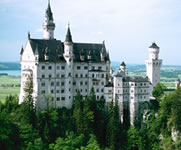The first hall in the cave is 30 feet high and above it there are 50 feet of stone. 27 yards further there was a cave-in. in October 1922 the cave-explorer, a mining engineer called Prof. Dr. Hans Brandt, gave the order to break a passage through the cave-in. His workers had to dig 30 feet before they found the natural course of the cave. During the next ten years the cave was extended to one mile, which can be visited up to now.
Germany for...
Show caves
The Devil's Cave
The first hall in the cave is 30 feet high and above it there are 50 feet of stone. 27 yards further there was a cave-in. in October 1922 the cave-explorer, a mining engineer called Prof. Dr. Hans Brandt, gave the order to break a passage through the cave-in. His workers had to dig 30 feet before they found the natural course of the cave. During the next ten years the cave was extended to one mile, which can be visited up to now.
Next to the journey into "Devil's Cave" is "Bear's Grotto". One finds mass piles of animal bones and the skulls of many cave bears. The animals had lived here during the ice age and also died here. It is generally believed, that the cave bears were locked in from the outside world through the sudden cave-ins and starved to death. Visitors can see even a complete skeleton of a cave bear. The bear was approximately 12 feet high and his weight was 900 pounds.
If the visitor looks downwards in the "Barbarossa Dome" he can see the deepest location of the cave: it is situated 230 feet below the upper surface of the cavern. The visitor has to go up "Mount Calvary" and after he has reached the last step, he can see the multi-colour illuminated "Crucifixion" to his right.
Further information:
Verkehrsbüro Pottenstein
D- 91278 Pottenstein
Tel.: +49 (0) 9243/708-41 & -42
Fax: +49 (0) 9243/708-40
Verkehrsbüro Pottenstein
D- 91278 Pottenstein
Tel.: +49 (0) 9243/708-41 & -42
Fax: +49 (0) 9243/708-40
Travel Planner
Select an option...



